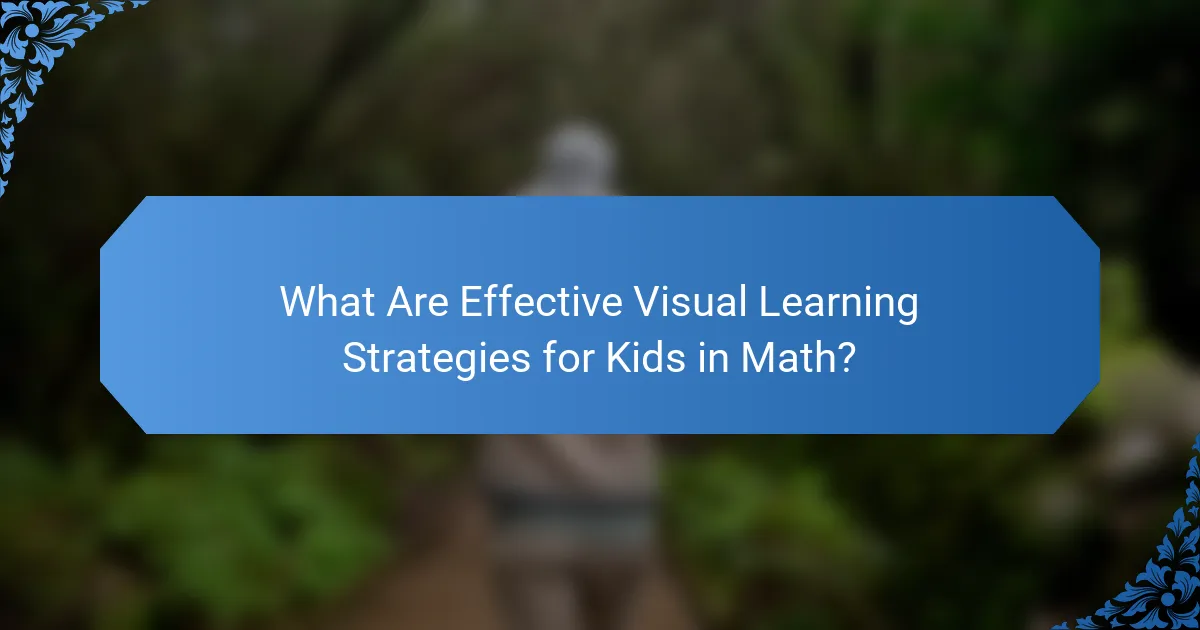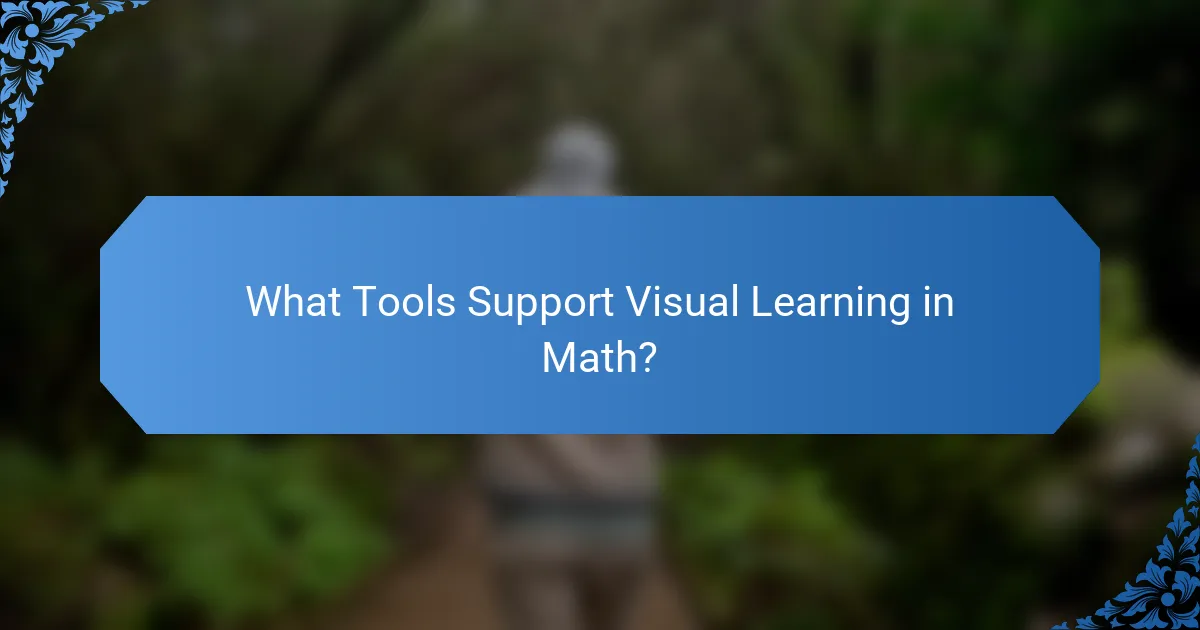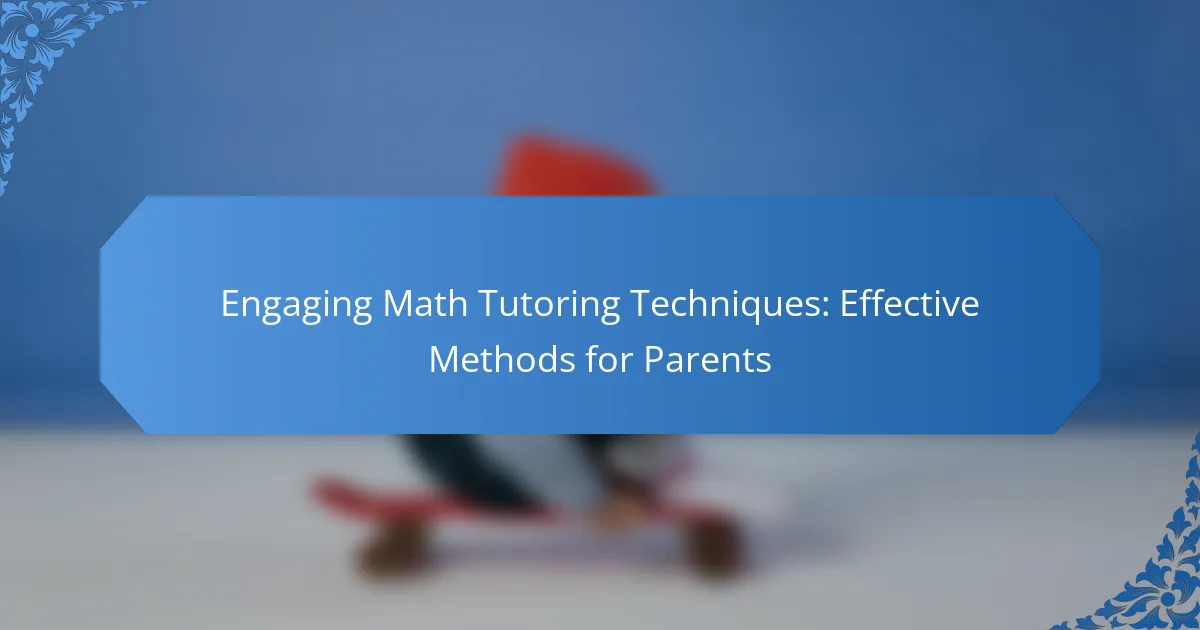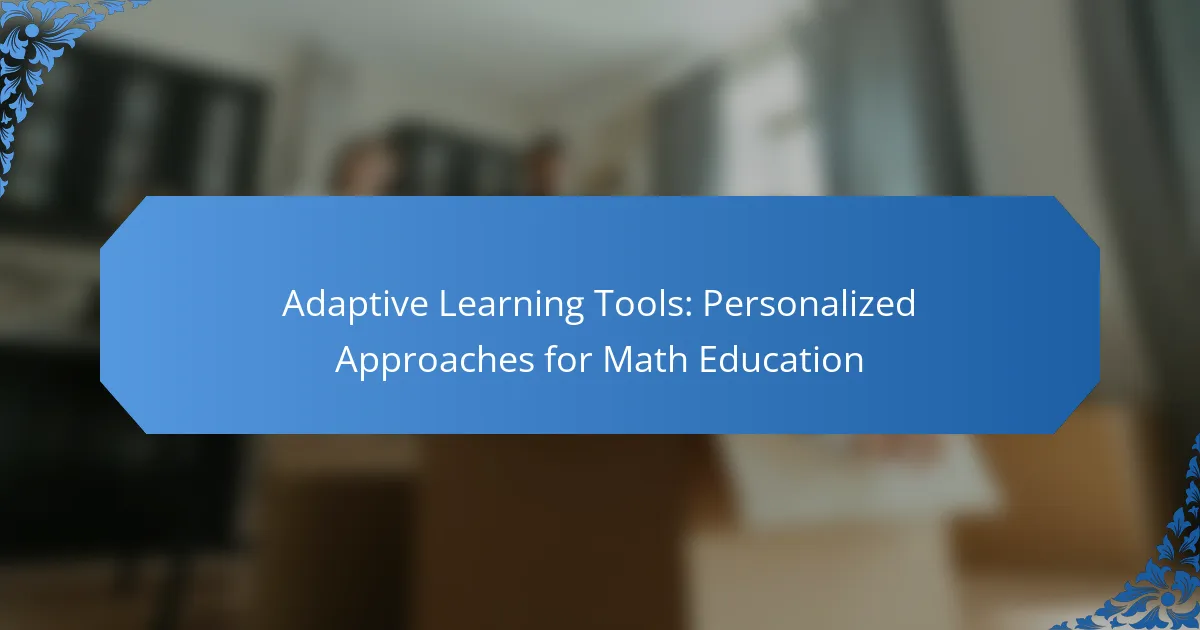Visual learning strategies are essential for helping kids understand math concepts by utilizing images, diagrams, and other visual aids. These techniques engage children’s visual senses, making abstract ideas more concrete and easier to grasp. By catering to different learning styles, visual learning not only enhances retention but also improves problem-solving skills in mathematics.

What Are Effective Visual Learning Strategies for Kids in Math?
Effective visual learning strategies for kids in math involve using various techniques that enhance understanding through visual representation. These strategies help children grasp mathematical concepts more easily by engaging their visual senses and making abstract ideas more concrete.
Use of Visual Aids
Visual aids such as charts, graphs, and diagrams can significantly enhance a child’s understanding of math concepts. For example, using pie charts to explain fractions allows kids to see the parts of a whole visually, making it easier to comprehend. Incorporating visual aids in lessons can cater to different learning styles, ensuring that all students grasp the material effectively.
When selecting visual aids, consider the age and comprehension level of the child. Simple, colorful visuals often work best for younger students, while more complex representations can be introduced as they advance in their studies.
Incorporating Games
Math games can make learning fun and interactive, helping kids to engage with mathematical concepts in a playful manner. Games like bingo with math problems or online platforms that offer math challenges can motivate children to practice their skills. These activities not only reinforce learning but also encourage teamwork and problem-solving.
Choose games that are age-appropriate and align with the math topics being taught. Regularly rotating games can keep the learning experience fresh and exciting, preventing boredom.
Utilizing Color Coding
Color coding can be a powerful tool for visual learners in math. By assigning different colors to specific types of problems or concepts, children can quickly identify and categorize information. For instance, using one color for addition and another for subtraction can help students differentiate between operations at a glance.
Encourage kids to use colored markers or highlighters when working on math problems. This technique not only aids in organization but also enhances memory retention by creating visual associations.
Interactive Whiteboards
Interactive whiteboards provide a dynamic platform for teaching math concepts visually. Teachers can illustrate problems in real-time, allowing for immediate feedback and interaction. Students can also participate by solving problems on the board, which fosters engagement and collaboration.
When using interactive whiteboards, incorporate multimedia elements such as videos or animations to further enhance understanding. This technology can be particularly effective in classrooms, making lessons more engaging for all students.
Storytelling Techniques
Storytelling can transform math lessons into relatable narratives, helping kids understand the relevance of math in everyday life. By framing math problems within a story context, children can better connect with the material and see its application. For example, using a story about shopping can illustrate addition and subtraction through real-life scenarios.
Encourage students to create their own math stories, which can reinforce their understanding and allow for creative expression. This approach not only makes learning enjoyable but also helps solidify mathematical concepts in their minds.

How Can Visual Learning Improve Math Skills?
Visual learning enhances math skills by using images, diagrams, and other visual aids to help children grasp mathematical concepts more effectively. This approach caters to various learning styles, making it easier for kids to retain information and apply it in problem-solving scenarios.
Enhances Retention
Visual learning strategies significantly boost retention by creating strong mental images associated with mathematical concepts. When children visualize problems, they are more likely to remember the steps needed to solve them. For example, using colorful charts or graphs can help solidify the understanding of data representation.
To maximize retention, incorporate visual aids like flashcards or mind maps during study sessions. These tools can help reinforce learning and make it easier for kids to recall information during tests or homework assignments.
Facilitates Understanding
Visual learning facilitates understanding by breaking down complex math concepts into simpler, more digestible parts. Diagrams and visual representations can clarify relationships between numbers, such as using pie charts to illustrate fractions. This method allows children to see the ‘big picture’ and understand how different elements connect.
Encourage the use of manipulatives, such as blocks or counters, to represent mathematical problems physically. This hands-on approach can deepen comprehension and provide a tangible way to explore abstract concepts.
Boosts Engagement
Visual learning boosts engagement by making math more interactive and enjoyable for children. When lessons incorporate visuals, kids are more likely to participate actively and stay focused. For instance, using educational videos or interactive software can capture their interest and motivate them to explore math further.
To maintain high levels of engagement, vary the types of visual aids used in lessons. Incorporate games, infographics, and real-life examples to keep learning dynamic and relevant. This variety can help sustain children’s attention and encourage a positive attitude toward math.

What Tools Support Visual Learning in Math?
Visual learning in math can be significantly enhanced through various tools that cater to different learning styles. These tools help children grasp mathematical concepts by providing visual representations and interactive experiences.
Math Manipulatives
Math manipulatives are physical objects that children can use to visualize and understand mathematical concepts. Common examples include blocks, counters, and geometric shapes. These tools allow kids to explore addition, subtraction, multiplication, and division through hands-on activities.
When using manipulatives, it’s essential to encourage students to explain their thought processes. This not only reinforces their understanding but also helps develop their communication skills. A good practice is to start with simple tasks and gradually introduce more complex problems as their confidence grows.
Educational Apps
Educational apps designed for math learning can provide engaging visual experiences that cater to various skill levels. Many apps incorporate games, interactive quizzes, and visual aids to make learning fun and effective. Popular options include Prodigy Math and Mathletics.
When selecting an app, consider its alignment with educational standards and its ability to track progress. Look for features that allow customization to meet individual learning needs, ensuring that children remain challenged yet not overwhelmed.
Online Platforms like Khan Academy
Online platforms such as Khan Academy offer a wealth of resources for visual learning in math. They provide instructional videos, practice exercises, and personalized learning dashboards that help students learn at their own pace. The visual explanations in these videos can clarify complex concepts.
To maximize the benefits of these platforms, encourage regular practice and exploration of different topics. Setting specific goals, such as completing a certain number of exercises each week, can help maintain motivation and track progress effectively.

What Are the Prerequisites for Implementing Visual Learning?
To effectively implement visual learning strategies, educators need to understand the foundational elements that support this approach. Key prerequisites include familiarity with different learning styles, an assessment of individual student needs, and access to appropriate visual resources.
Understanding Learning Styles
Recognizing that students have diverse learning styles is essential for effective visual learning. Visual learners tend to grasp information better when it is presented through images, diagrams, and charts rather than through text alone. Educators should consider incorporating various visual aids to cater to these preferences.
Common learning styles include visual, auditory, and kinesthetic. While visual learners thrive on graphical representations, auditory learners benefit from spoken instructions, and kinesthetic learners excel through hands-on activities. Understanding these differences allows for a more tailored educational experience.
Assessing Student Needs
Assessing the needs of students is crucial for implementing visual learning strategies effectively. This can be done through informal observations, quizzes, or discussions to identify which students respond best to visual aids. Understanding each student’s unique challenges and strengths will help in selecting the right materials.
Additionally, consider conducting surveys or using assessment tools to gather data on student preferences. This information can guide the selection of visual resources, ensuring they align with the students’ learning objectives and enhance their engagement in math concepts.

How Do Parents and Teachers Collaborate on Visual Learning?
Parents and teachers can effectively collaborate on visual learning by sharing insights and strategies that enhance children’s understanding of math concepts. This partnership is crucial for creating a cohesive learning environment that supports visual learners.
Sharing Resources
Sharing resources is essential for parents and teachers to align their approaches to visual learning. This can include exchanging educational materials such as worksheets, visual aids, and online tools that cater to different learning styles. For example, teachers might provide parents with links to interactive math games that reinforce classroom lessons.
Additionally, parents can share insights about their child’s preferences and challenges, helping teachers tailor their resources accordingly. A collaborative resource list can be created, featuring websites, apps, and books that focus on visual learning strategies in math.
Regular Communication
Regular communication between parents and teachers fosters a supportive environment for visual learning. Setting up weekly or bi-weekly check-ins can help both parties stay informed about the child’s progress and any difficulties they may encounter. This ongoing dialogue allows for timely adjustments to teaching methods or home support strategies.
Utilizing communication tools such as emails, messaging apps, or parent-teacher conferences can enhance this collaboration. Parents should feel encouraged to ask questions and share observations, while teachers can provide feedback and suggest specific activities to reinforce visual learning at home.



